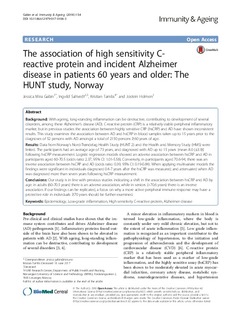| dc.contributor.author | Gabin, Jessica Mira | |
| dc.contributor.author | Saltvedt, Ingvild | |
| dc.contributor.author | Tambs, Kristian | |
| dc.contributor.author | Holmen, Jostein | |
| dc.date.accessioned | 2019-04-02T09:08:56Z | |
| dc.date.available | 2019-04-02T09:08:56Z | |
| dc.date.created | 2018-06-29T11:48:54Z | |
| dc.date.issued | 2018 | |
| dc.identifier.citation | Immunity & Ageing. 2018, 15 (4), . | nb_NO |
| dc.identifier.issn | 1742-4933 | |
| dc.identifier.uri | http://hdl.handle.net/11250/2592867 | |
| dc.description.abstract | Background
With ageing, long-standing inflammation can be destructive, contributing to development of several disorders, among these Alzheimer’s disease (AD). C-reactive protein (CRP) is a relatively stable peripheral inflammatory marker, but in previous studies the association between highly sensitive CRP (hsCRP) and AD have shown inconsistent results. This study examines the association between AD and hsCRP in blood samples taken up to 15 years prior to the diagnoses of 52 persons with AD amongst a total of 2150 persons ≥60 years of age.
Results
Data from Norway’s Nord-Trøndelag Health Study (HUNT 2) and the Health and Memory Study (HMS) were linked. The participants had an average age of 73 years, and diagnosed with AD up to 15 years [mean 8.0 (±3.9)] following hsCRP measurement. Logistic regression models showed an adverse association between hsCRP and AD in participants aged 60-70.5 (odds ratio: 2.37, 95% CI: 1.01-5.58). Conversely, in participants aged 70.6-94, there was an inverse association between hsCRP and AD (odds ratio: 0.39, 95% CI: 0.19-0.84). When applying multivariate models the findings were significant in individuals diagnosed 0.4-7 years after the hsCRP was measured; and attenuated when AD was diagnosed more than seven years following hsCRP measurement.
Conclusions
Our study is in line with previous studies indicating a shift in the association between hsCRP and AD by age: in adults (60-70.5 years) there is an adverse association, while in seniors (>70.6 years) there is an inverse association. If our findings can be replicated, a focus on why a more active peripheral immune response may have a protective role in individuals ≥70 years should be further examined. | nb_NO |
| dc.language.iso | eng | nb_NO |
| dc.publisher | BMC | nb_NO |
| dc.relation.uri | https://immunityageing.biomedcentral.com/track/pdf/10.1186/s12979-017-0106-3 | |
| dc.rights | Navngivelse 4.0 Internasjonal | * |
| dc.rights.uri | http://creativecommons.org/licenses/by/4.0/deed.no | * |
| dc.title | The association of high sensitivity C-reactive protein and incident Alzheimer disease in patients 60 years and older: The HUNT study, Norway | nb_NO |
| dc.type | Journal article | nb_NO |
| dc.type | Peer reviewed | nb_NO |
| dc.description.version | publishedVersion | nb_NO |
| dc.source.pagenumber | 8 | nb_NO |
| dc.source.volume | 15 | nb_NO |
| dc.source.journal | Immunity & Ageing | nb_NO |
| dc.source.issue | 4 | nb_NO |
| dc.identifier.doi | 10.1186/s12979-017-0106-3 | |
| dc.identifier.cristin | 1594717 | |
| dc.description.localcode | © The Author(s). 2018. This article is distributed under the terms of the Creative Commons Attribution 4.0 International License (http://creativecommons.org/licenses/by/4.0/), which permits unrestricted use, distribution, and reproduction in any medium, provided you give appropriate credit to the original author(s) and the source, provide a link to the Creative Commons license, and indicate if changes were made. The Creative Commons Public Domain Dedication waiver (http://creativecommons.org/publicdomain/zero/1.0/) applies to the data made available in this article, unless otherwise stated. | nb_NO |
| cristin.unitcode | 194,65,20,15 | |
| cristin.unitcode | 194,65,30,0 | |
| cristin.unitname | Helseundersøkelsen i Nord-Trøndelag | |
| cristin.unitname | Institutt for nevromedisin og bevegelsesvitenskap | |
| cristin.ispublished | true | |
| cristin.fulltext | original | |
| cristin.qualitycode | 1 | |

